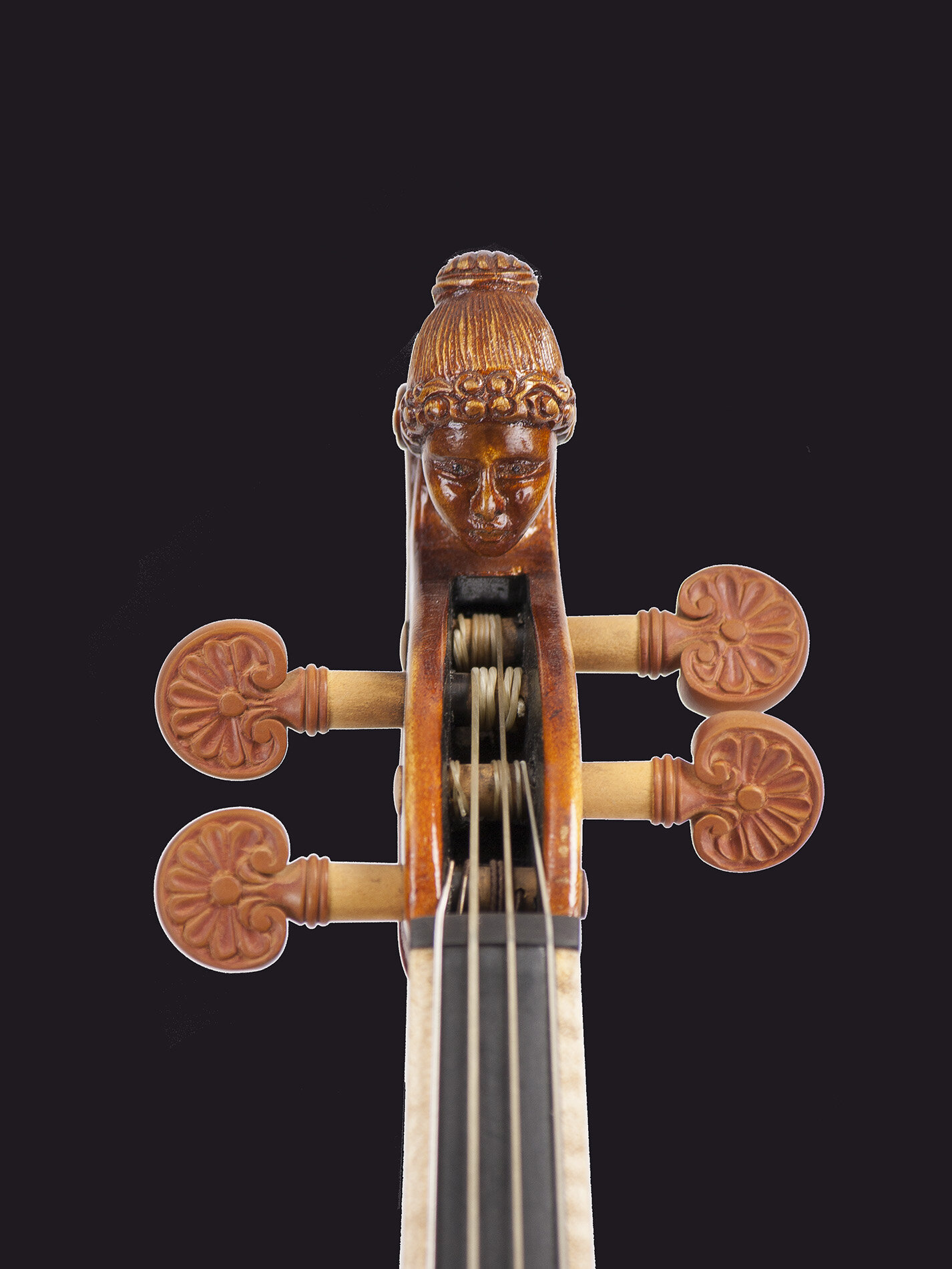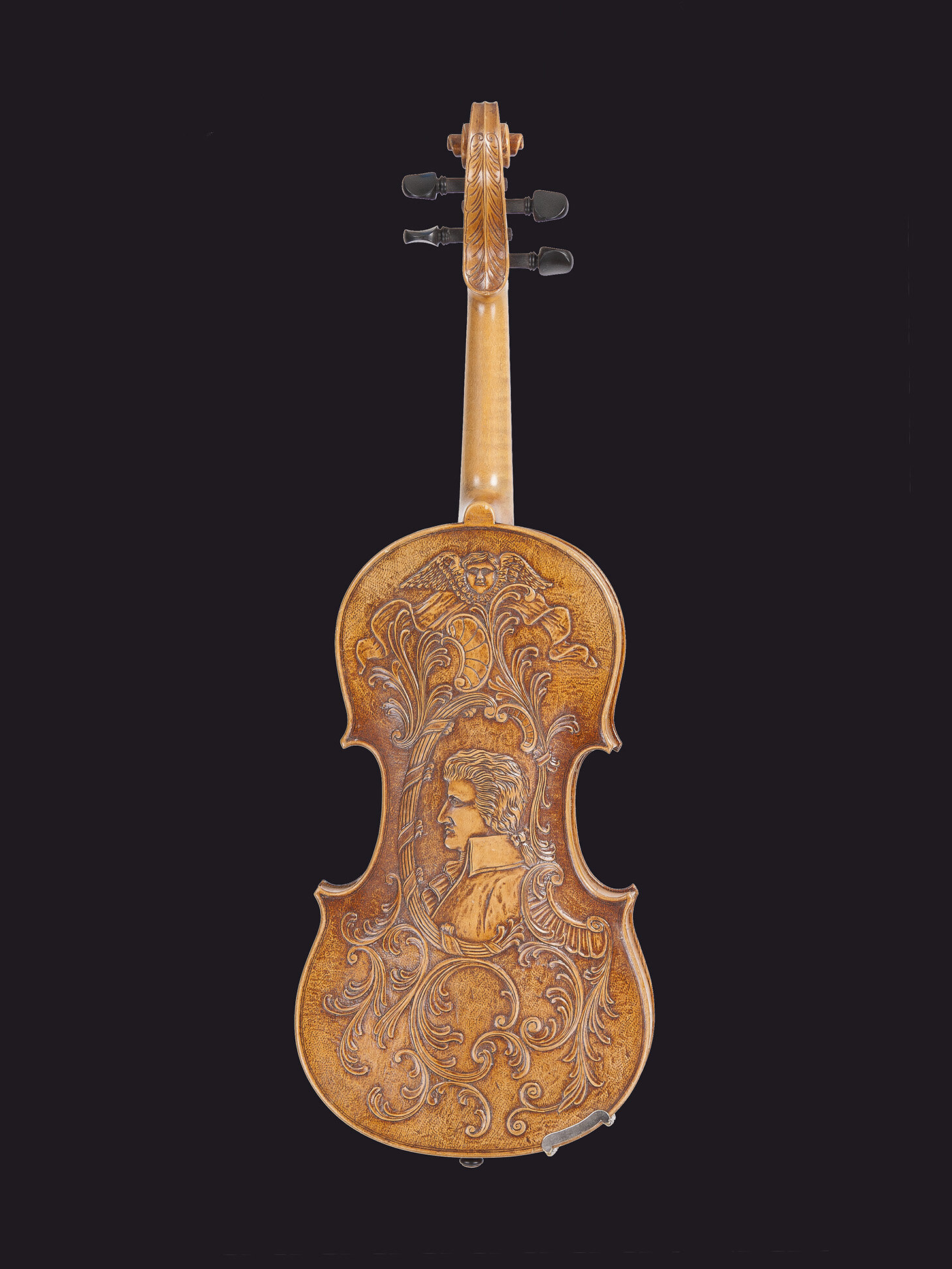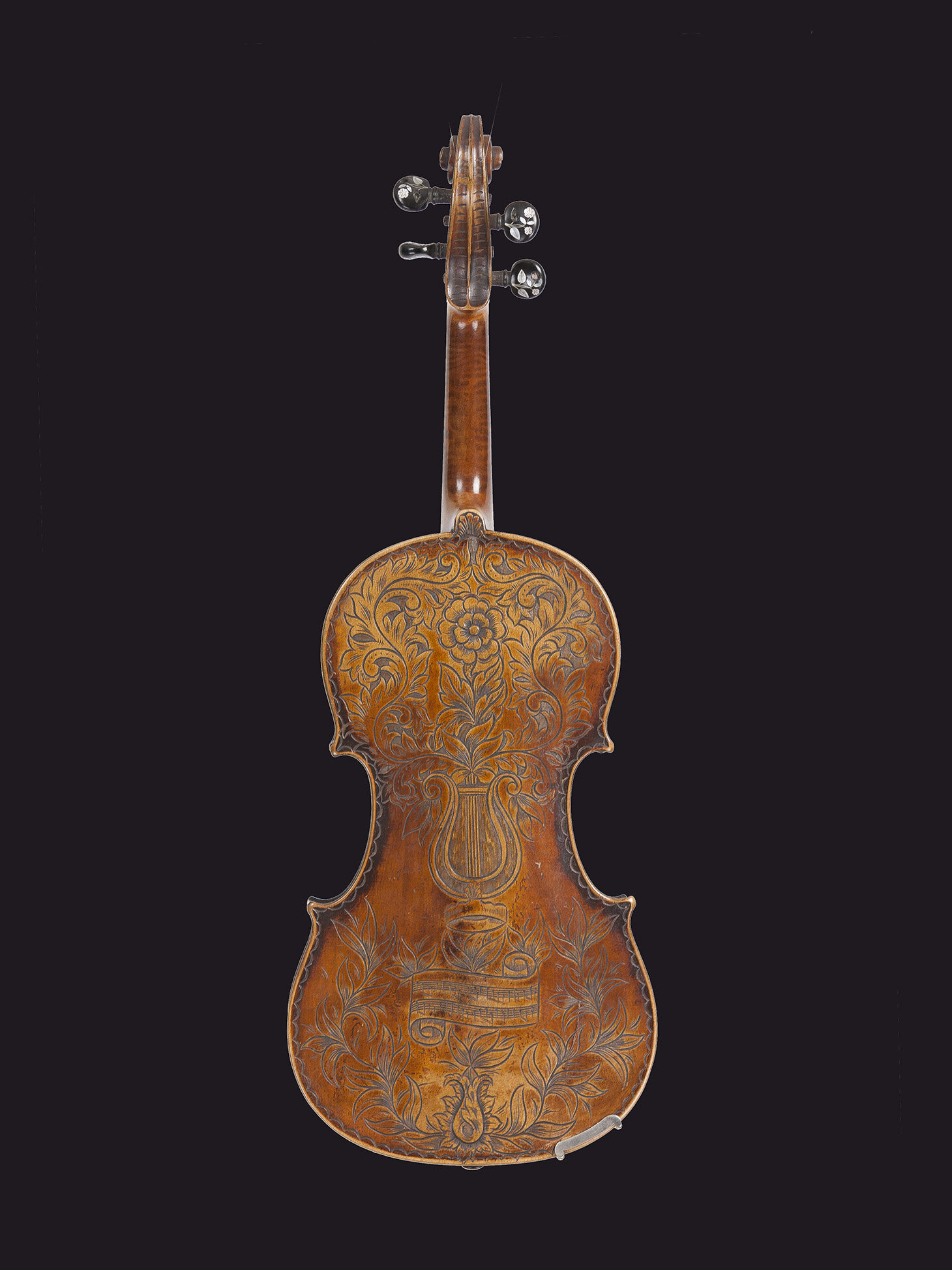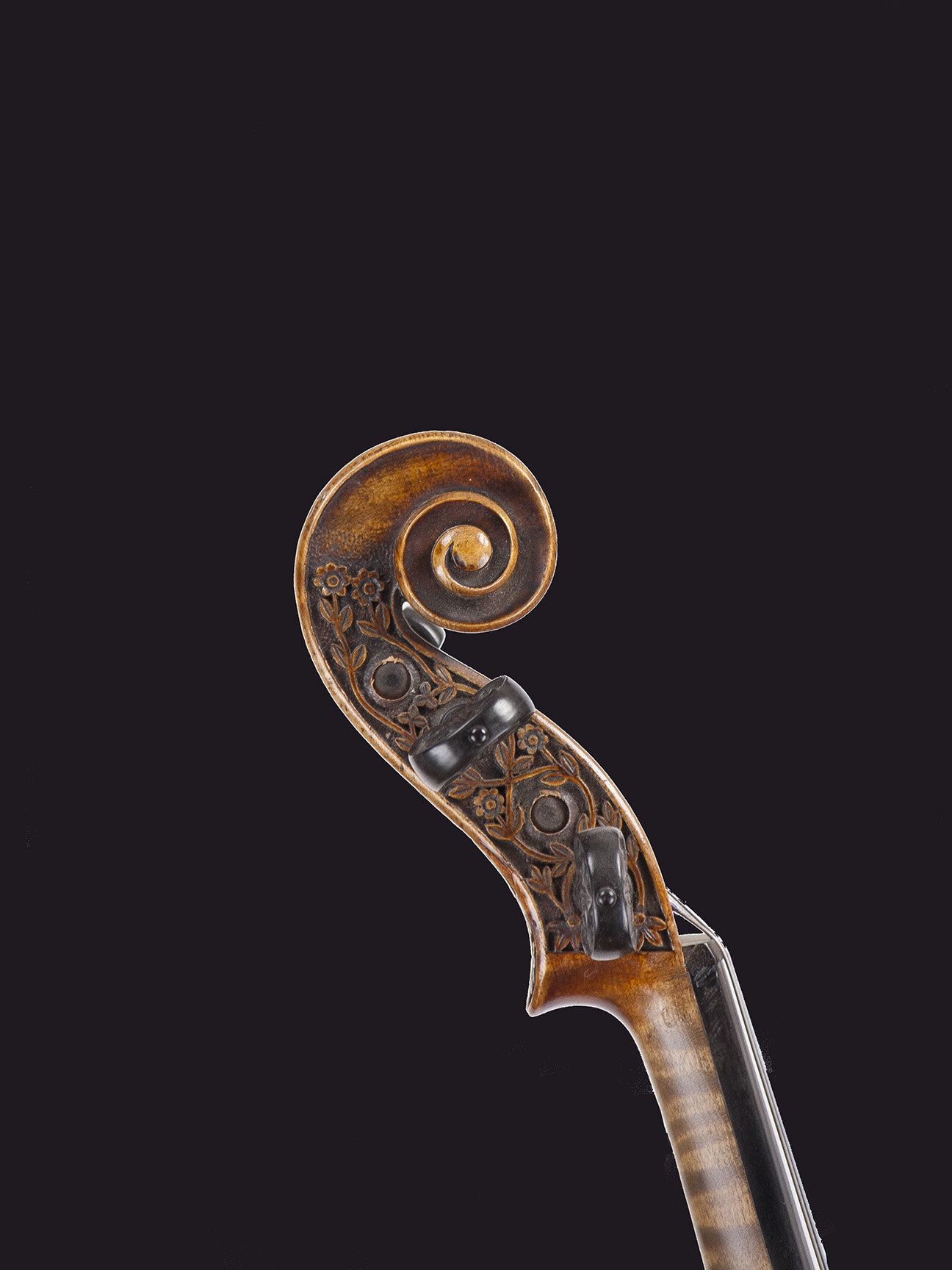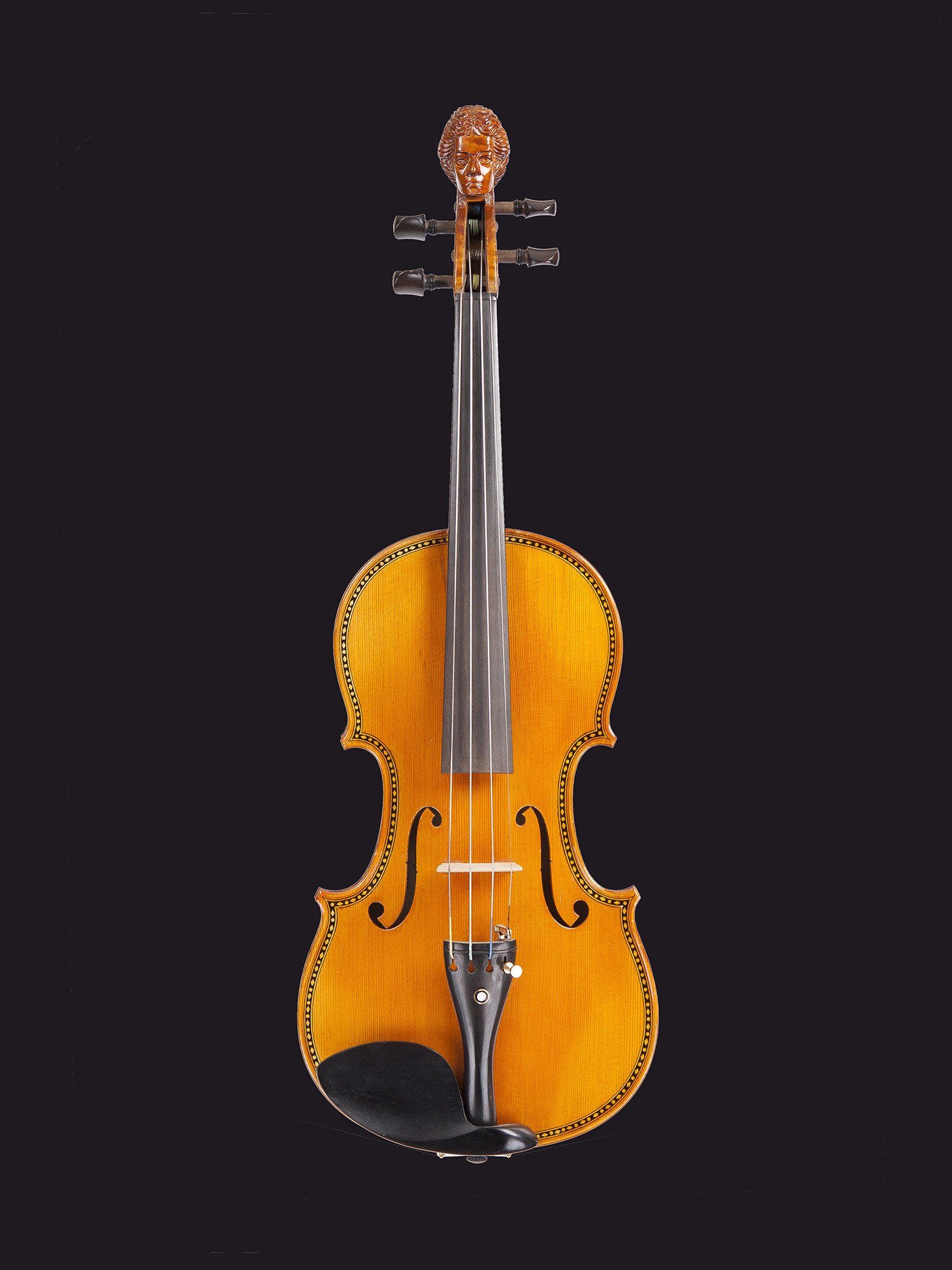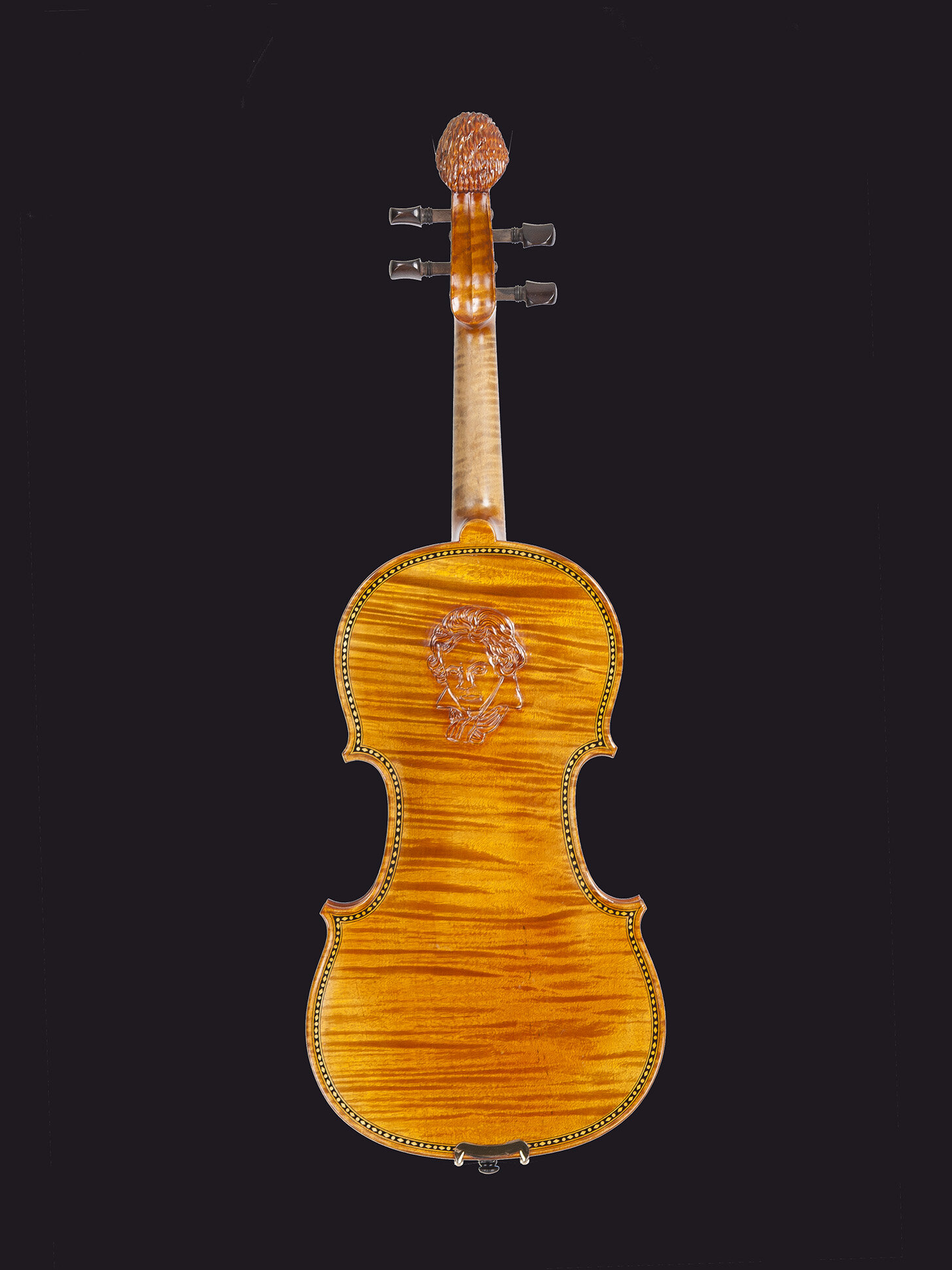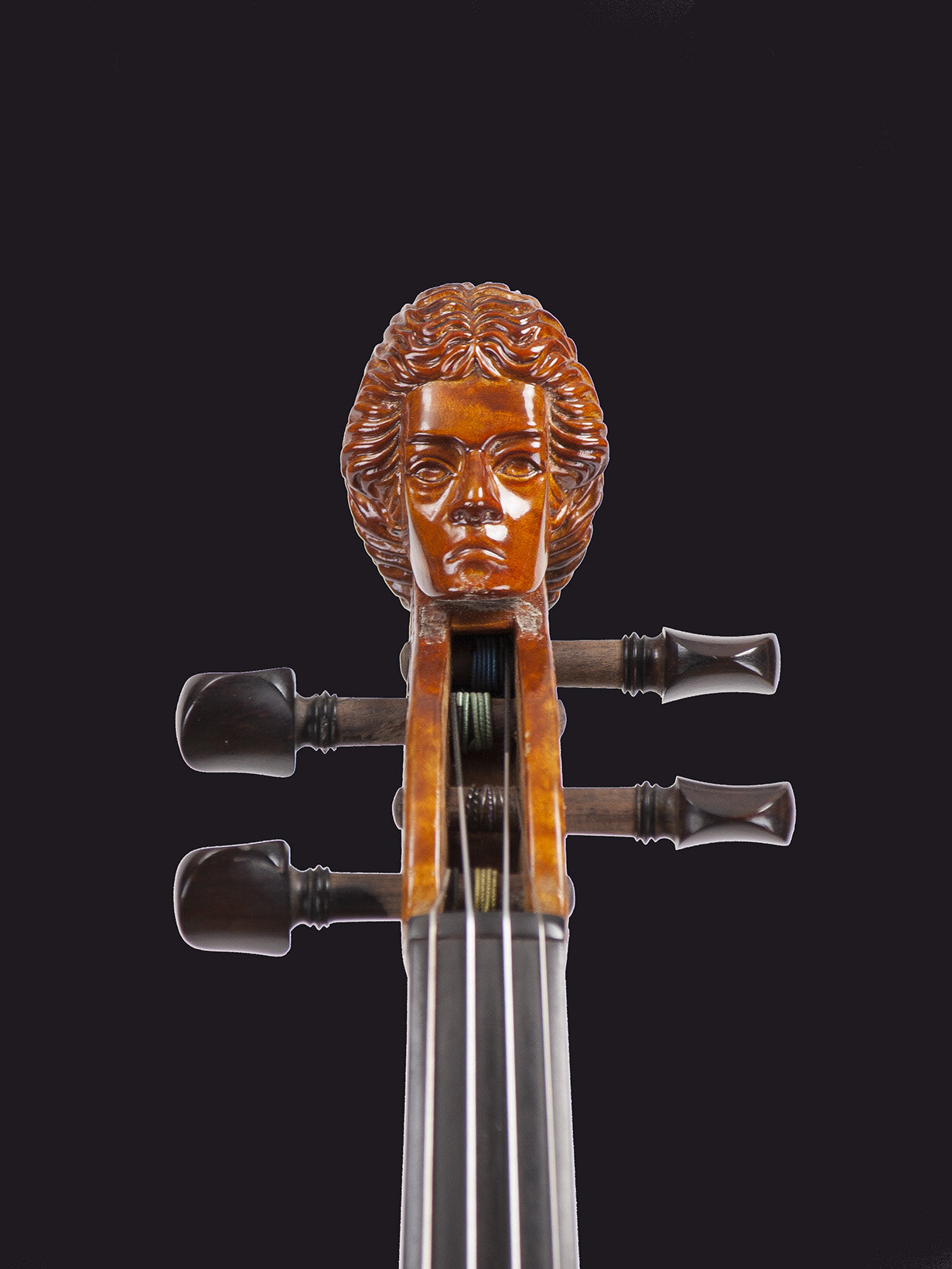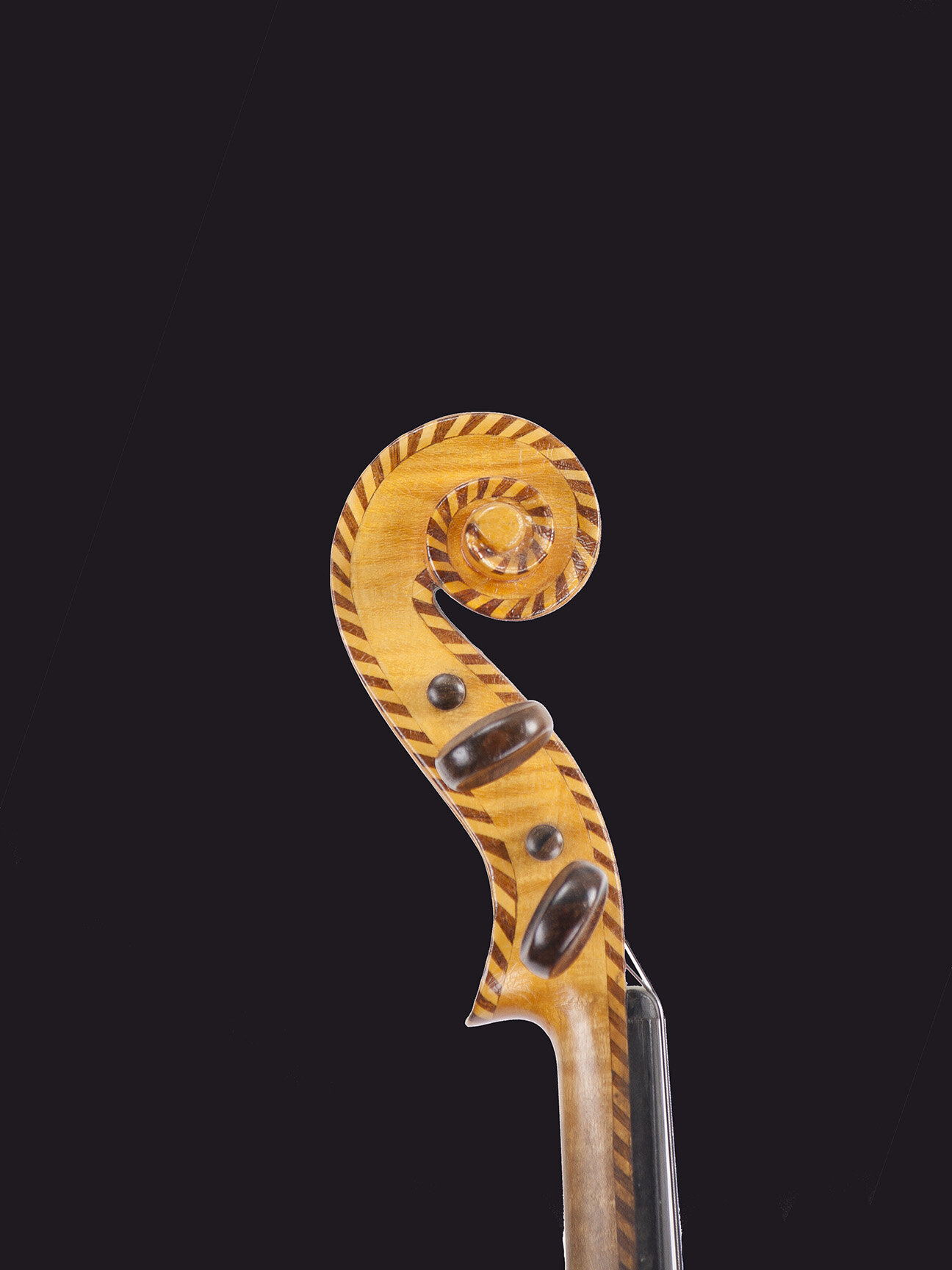Fancy Fiddles
Our Fancy Fiddle collection is the result of 45+ years as a violin shop. As with anything, you’ll be surprised at what you can find if you spend enough time looking. Each of these instruments has a different story to tell: from the heritage of a country, to serving practical purposes, to showcasing the skill of the luthier.
We hope you enjoy this unique collection. Check out the video of the fiddles with Jeremy Bartel or scroll down the page to view images and descriptions.
If you just want to browse the images head to the Fancy Fiddle Gallery.
Trumpet Violin
The trumpet violin actually serves a very important purpose. Violins (as well as violas, cellos and basses) are very sensitive to changes in temperature and humidity. Those changes can cause serious damage, at worst, or will harm the tone of an instrument. Tut-ta-ta-taaaa (trumpet fanfare) that is where the trumpet violin comes in.
For street performers you would be hard pressed to find something that will hold up to the elements quite like this instrument. You’ll notice there are two bells on the violin, a larger one facing out towards the audience and smaller one facing towards the player. This allows for the player to get feedback on their playing. Same as they would on a normal violin.
Trumpet violins were also used in the early days of recording because they are much louder than a standard wooden violin.
Aluminum Violin
Aluminum instruments were not extremely common, even when they were being made primarily in the 1920s and 1930s. Violins, cellos and basses were all being made out of the material as it was becoming less expensive due to improvements in aluminum production. The production of these instruments most certainly stopped due to the outbreak of WWII and the need for aluminum production to serve the war effort. Coincidentally, it is thought that many of the aluminum instruments that were manufactured before the war were used by musicians on naval ships because of their sturdiness.
Aluminum instruments were produced both by American and European companies. The difference between the two styles is that the American instruments were made entirely out of aluminum, whereas the European models included a wood neck, scroll, bass bar, blocks and sound posts. With that in mind the aluminum violin in our shop is of European origin. The American companies making aluminum instruments were the Aluminum Musical Instrument Company in Ann Arbor, MI and ALCOA (Aluminum Company of America). In Europe the main company noted for producing these instruments was the G.A. Pfretzschner workshop in Marneukirchen, Germany.
Silent Violin
We LOVE the violin but there are times where those around you might not be so keen to listen to your practicing. Sure, you could buy a mute to place on the strings which makes sense for a lot of practical reasons, but no mute looks as cool as a silent violin.
As you are aware the hollow body of a violin, viola, cello or bass serves as a speaker to amplify the sound of the instrument. Take the body away and the sound diminishes to almost nothing. It’s quite amazing to listen to the difference between a normal violin and silent one and get an appreciation of just how well the standard violin actually works to project sound.
Silent violins are made by various manufacturers and come in some really interesting shapes, such as the one in our collection. They also serve as a great platform for electrification by adding pick-ups and being connected to an amplifier the same way you would use a solid body electric guitar or bass.
Pochette (Pocket Violin)
Isn’t it adorable? (Why are all tiny things adorable?? - We don’t know either)
The Pochette, or pocket violin, that was literally designed to fit in a pocket. Anyone who plays an instrument meant to be held can attest to the fact that while they might be portable they are not always convenient to carry around. This was likely one of the reasons they became popular along with the fact that they were less expensive than a full-size violin.
Even with their small size the fingerboard is of a decent length and allows for a good amount of range compared to the instrument size. When time comes to play a pochette it is not held under the chin, because there is nothing to hold on to, but is placed against the chest or along the upper arm.
Even though they might seem like a novelty and not a serious instrument, Antonio Stradivari - perhaps the greatest violin maker of all time, is known to have made a few pochettes and two of them have survived to this day.
Hardanger (Hardingfele)
The Hardanger, or Hardingfele, fiddle is a traditional stringed instrument considered to be a national instrument of Norway. As you can see they are very decorated with a lot of inlays throughout the instrument, ornate scroll carvings, ink designs on the body and a unique design of the F-holes.
The other thing that you notice quite immediately is the number of pegs on the instrument. This particular hardanger has nine pegs (some hardangers have eight) meaning the instrument has nine strings total. Four of the strings are setup as you would see on a typical violin and are strung over the bridge the tailpiece. The remaining five strings are sympathetic strings which resonate as the top four strings are played.
Hardangers differ from a standard violin beyond just the number of strings. The bridge is flatter than a standard violin so that more than one string can be easily played at a time to make full use of the multiple pitches offered by the sympathetic strings. The tuning is also different, hardangers are most commonly tuned to A-D-A-E (sympathetic strings to B-D-E-F♯-A) and a violin is tuned to G-D-A-E.
Castelli Baroque (Varnished and White)
This violin is from our for-sale inventory and is based on a violin our founder, Paul Bartel, really liked and wanted reproduced. It took him many years to find a maker who could make the instrument just the way he wanted. This particular model is a Baroque style violin, which is how violins were first made and is different in some subtle ways to the contemporary style. While those differences in styles are interesting in their own right, we really want to focus our attention to the craftsmanship of this particular instrument and give you some insight into the skill of a luthier.
As you’ll notice from the pictures we are showing this particular violin fully varnished and complete as well as in its raw, or white, state. The construction of a violin requires great skill from a luthier and some of the finer points are where an instrument and luthier can set themselves apart from the crowd.
This instrument is certainly set apart due to the detail in the scroll carving as well as the relief on the back. Scrolls are difficult to do in their standard form, carving to this detail takes great skill and the relief work on the back is also challenging. This instrument is meant to be played, so getting the balance between playability and artistry is walking a fine line. Many violins with relief on the back are very heavy, relatively speaking, and the extra wood on the back can harm the tone.
The pictures of this instrument varnished and “in the white” will hopefully give you a greater appreciation of the skill needed to give the wood an antique finish that looks like natural aging. Using different varnish colors and adding small artifacts (marks) on the instrument allows this violin, which is essentially brand new, to look like it is hundreds of years old.
Relief Fiddles
The fiddles in this group of instruments have relief carvings on the backs and sometimes on the front and scroll as well. The designs can vary greatly as you can see from the photographs, but as you might expect most are based on music/musicians, religion and national symbols.
These violins are not typically meant to be played as the extra wood on the front or back of the instrument can really harm the instrument tone. Over hundreds of years luthiers have been working to get the best possible sound out of their instruments and that requires carving both the inside and outside of the instrument to very thin thicknesses. While not necessarily an exact science that can be applied as a standard for every instrument or piece of wood, there are some guidelines as to what works and what doesn’t.
The relief fiddles, then, are the chance for luthiers to show their skill at detailed and ornate carvings as well as their varnishing ability, as seen in our Castelli violin.
Head Fiddles
Yep, these violins have heads and it’s not some horror movie plot gone wrong. Instead of a normal nautilus scroll design, the luthiers of these instruments decided to pay homage to a person by carving the their head on the scroll. As you might imagine the majority are dedicated to musicians or religious figures.
Head fiddles were made starting way back in the 1500s and had a resurgence in the early 1800s from a famous french maker, J.B. Vuillaume, who wanted to copy the originals that were created in Cremona, Italy. At the time Jean Joseph Derazey worked in the Vuillaume shop and began making these instruments as well. He set out on his own and continued to make the instruments and is probably the most well known maker to turn out these instruments.
They are primarily ornamental instruments but can be played. The head carving on the scroll does not impact the playability of the instruments. Only in cases where there is heavy or ornamentation on the back of the instrument with reliefs would the tone of the instrument be impacted.
Inlay Fiddles
Inlays in instruments are another way for a luthier to show their skill. Every violin of quality has at least one inlay, which is the perfling that surrounds the outline of the instrument. This double black line is actually a piece of wood, with ebony on either side and a small piece of filler wood in the middle. Perfling is added to the instrument by carving out a channel around the edge of the instrument and then placing the wood into the channel. The quality of the perfling goes a long way to determining the quality of an instrument.
Some makers have taken this further and place inlays throughout the body of the instrument. The attention to detail and painstaking carving is quite a feat considering the thickness of the wood they are working with. Go too far and you’ve gone right through the body of the instrument, not far enough and there is nothing to work with.
Inlays come in various forms but typically use other pieces of wood shaped to fit the carving, ebony dust and even mother of pearl or other similar material.
One popular inlay is to add a small riddle to the back “In silvis viva silui - Jam mortua cano” or translated “In life I was silent - In death I sing” any guesses what the luthiers are referring to? Need a hint? What is the violin made of….
Interesting Shapes
The shape of a violin has not really changed much over the course of a few hundred years. Once makers found a shape that worked well there wasn’t much reason for any drastic changes. However, luthiers are as much artists as they are craftspeople so they are bound to get creative…..
Perhaps they were thinking they could adjust the tone of the instrument with a different shape or maybe they were just bored on a Sunday and wanted to have some fun. Either way there have been some unusual shapes created. We have two instruments that are a bit unique in their shape, the “Stop Sign” violin and the “Vader” violin.
The “Stop Sign” has an octagonal shape to the upper and lower bouts while maintaining the normal curve of the middle bout. The “Vader” violin got the moniker due to its resemblance to the menacing helmet of Darth Vader from Star Wars.
Paint?
If there is one thing you could do to a violin to really choke out the sound it would be to paint it. Varnish has been developed for hundreds of years to be thin and light and allow the wood to resonate while giving it a beautiful look and offering some protection. But sometimes it’s not about the tone it’s about celebrating the beauty of the instrument itself and using it as a canvas.
This violin was airbrushed by a former luthier in our shop, he did airbrushing in his spare time and Paul asked him to create something that would simply show the beauty of his work as well as show the beauty of the violin shape. We think what he did is amazing and it is certainly one of the most noticed instruments we have in the shop.
Again, you wouldn’t ever want to play a painted violin but simply admire it.
















